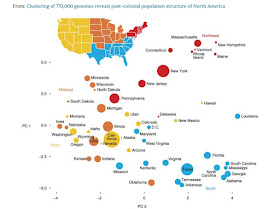 |
| Charles Darwin (b. 1809, d. 1882 |
Within the past week of starting this series, I have heard two long narratives about the impact of genealogical DNA testing where the tests revealed new relatives, principally previously unknown parents. It seems clear that continued DNA testing will impact a huge number of individuals and families with results that will be disruptive and deeply disturbing. This by-product of genealogical DNA testing is largely ignored by the large online DNA testing companies who continually show how families have been emotionally reunited. Even prominent public individuals are being scrutinized because of their claims to a certain ancestry and even vilified for claiming a certain descendancy.
The benefits of genealogical DNA testing are less evident than the advertisements for the testing products might suggest. The beneficial effects attenuate with each generation back in time. The most prominently featured results claim to reveal your cultural ethnicity when it is clear from even a superficial examination, that the ethnicity reports, despite their sophisticated graphic representations, are vague at best and misleading in any detailed examination. As the testing procedures and analysis of the results become more sophisticated and detailed, there will be an increase in the overall utility of the tests. But we are presently in a time of rapid reevaluation and as the results change, most recipients of the test results will see their "ethnicity" evolve. Meanwhile, advances in the analysis of the test results will render the information about relationships in the first six ancestral generations highly useful to those who are investigating their ancestry in systematic and source-based ways.
The reality of the genealogical DNA testing is that the test results are particularly useful only when accompanied by a well-researched family tree. Therefore, the utility of the genealogical DNA tests for most of those who have taken a DNA test will revolve around the accuracy of their compiled online family tree. Without a well-researched family tree, a DNA test merely satisfies a curiosity.
One important question is how much of the detailed information about genetics is necessary to utilize DNA testing in a genealogical context? Genetics is like any other academic or professional pursuit; it has generated its own complex system of jargon. Jargon is a technical term that refers to a type of language that is used in a particular context and is only understood and accepted in a particular activity or group. These technical terms are used to communicate within the group and tend to exclude those who are not part of the group. As an attorney, I spent much of my initial legal studies learning the "jargon" of the legal profession. There is a common saying among attorneys, that becoming a lawyer or attorney consists mainly of learning how to sound like one. Likewise, becoming a DNA or genetics "expert" consists of learning the jargon and being able to articulate it in a way that impresses the non-initiate. Those who cannot spout the accepted jargon are immediately dismissed as novices or worse.
Of course, there are those who are involved directly in the activity of being a geneticist or a student of heredity and variations inherited characteristics. There are now a large number of major universities around the world that offer advanced degrees in molecular biology and genetics. The rankings of these universities correspond with their raking as global universities and they include universities such as Harvard University, University of Cambridge, the Massachusetts Institute of Technology and other such institutions. See "Top 10 Global Universities for Molecular Biology, Genetics." In the academic world, recognition as an expert involves a complex relationship between published academic papers and important discoveries.
In contrast, very few of the DNA experts recognized by the genealogical community have any particular expertise or recognition in the academic community of either molecular biology or genetics. However, there are quite a few trained geneticists who have written about genealogical DNA testing. See the following:
- What I actually learned about my family after trying 5 DNA ancestry tests
- What can a DNA test actually reveal about your ancestry?
- Pulling Back the Curtain on DNA Ancestry Tests
- Ancestry Tests Pose a Threat to Our Social Fabric
- How Accurate Are Online DNA Tests?
So what is the purpose of writing a detailed history of genealogical DNA testing? For the past few years, I have been studying and reading about genetics and its relationship to genealogy. As a trial attorney, I am accustomed to learning about new subjects, usually under pressure of an imminent trial. I think that my years of involvement in our legal system, more than 37 years of genealogical research, my background in linguistics, my years of study of genealogical DNA and the issues raised by genealogical DNA testing are mutually conducive to such an undertaking. What I think is important is that I break through the jargon and discuss the practical aspects of genealogical DNA testing. Does that make me an expert? Not likely. Experts in genealogy just as in every other profession and academic pursuit are, as I stated above, recognized by their publications and peer recognition. Despite my actual background and knowledge, I doubt that any of recognized "experts" will welcome me into their community. For you, the reader, I suggest that you read what I write and check my sources. As is my custom, I will aggregate everything I can find on a subject I write about and I will provide extensive links to every part of my writing.
Here we go. Stay tuned for the coming installments.





























